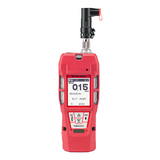Blog
Benzene Gas Detector: RKI Instruments New GX-6000 Gas Monitor with Benzene Specific Measuring Mode
RKI Instruments’ product philosophy is based on the core belief that gas detection devices should be built to last. The advantages of gas monitors engineered by RKI Instruments include their proven reliability and accuracy. The GX-6000 Monitor is a game changer, and it just got even better with the Benzene Specific measuring mode. With the new highly selective 10.0 eV PID sensor, the GX-6000 can now detect the BTEX family of VOC’s including benzene, toluene, ethylbenzene, and xylene with a ra
…
Oct 26th 2017
PK Safety's Top 5 Paired Safety Products for Cinco De Mayo 2017
Let the
Cinco de Mayo festivities begin early! Find your sombreros, grab some amigos, and shop our top 5 must-have safety products, perfectly paired for your easy everyday protection.Pair 1: Gas Detector + Docking Station
The BW Clip4 Four Gas Detector provides portable, easy-to-use multi?gas detection that’s always on. It detects Oxygen (O2), Hydrogen sulfide (H2S), Carbon monoxide (CO), Lower Explosive Levels (LEL) of a variety of combustible gases. It offers a full 2?year warranty
…
May 2nd 2017
Confined Space Entry — Top 3 Safety Tips
When working in confined spaces, it’s critical that workers stay safe from hidden and potentially deadly dangers. These spaces - which, according to the U.S. Department of Labor’s Occupational Health and Safety Administration, are usually small and difficult to exit - can include places like coal mines, manholes, grain elevators or wine tanks, along with many others. OSHA recognized this and created more confined space regulations in 2015.Why is OSHA Focusing on Confined Spaces?The danger of the
…
Mar 16th 2017
What's New in the World of RKI Gas Detection?
Gas detectors are essential for confined space monitoring before and after the entry. RKI designs high-rated topside and diffusion gas monitors for these purposes.
Topside Monitors
The
GX-2012 is an active pumped four-gas monitor with sensors engineered to detect Hydrogen Sulfide (H2S), Carbon Monoxide (CO), Oxygen (O2) and combustible gases (LEL). Its powerful internal pump is able to pull samples from up to 50 ft. away! This key feature makes it a perfect topside moni
…
Nov 15th 2016
4 Reasons You Will Love the New BW Clip4 Multi-Gas Detector
BW Technologies is introducing a new disposable multi-gas monitor that doesn’t need charging after activation. Know your team has an active, working monitor out in the field, and not one with a dead battery. The BW Clip4 Four Gas Detector simultaneously measures H2S, O2, LEL, CO, and is available in
a black or a yellow impact-resistant housing. It is built with IR technology which gives this detector a number of advantages. Infrared (IR) technology-based devices are reliable, fast-detectin
…
Nov 9th 2016
Gas Detection Solutions for Commercial Spaces
Confined spaces become hazardous areas when exhaust gathers from cars, trucks, buses, tractors, trailers, forklifts, and other fossil fuel burning engines. Exhaust fumes are highly toxic and exposure to the fumes can result in serious health problems, and even death. That is why the CO and NO2 levels must be measured, and when concentrations reach unsafe, unhealthy levels, the areas must be ventilated. Reliable detection can also protect those who work in these areas from accidents like explo
…
Jul 22nd 2016
OSHA Says Attics and Crawl Spaces Require 4-Gas Monitors
Plumbers, electricians, carpenters, HVAC techs and many other tradesmen find themselves crawling around attics and crawlspaces on a regular basis. Now they are going to need to bring one more piece of equipment with them - a
personal 4-gas monitor. OSHA has recently clarified their standard concerning these very routine work areas and they are officially now classified as confined spaces.
Confined spaces are inherently dangerous, and OSHA's not unreasonable response is to require add
…
Feb 19th 2016
How to Put a Fixed Gas Detection System in Your Facility
Flammable and toxic gas detection is a must for many oil refineries, offshore platforms, laboratories, chemical production plants, and public works facilities. If your work requires constant gas monitoring, you need a reliable, easy-to-maintain fixed gas sensor system that will warn you quickly if a problem arises.
How complicated a fixed gas system depends largely on the use of the data provided by the sensors. For example, if a fixed gas detection system is used only for warning nearb
…
Oct 16th 2015
Personal H2S Monitors For Less
If your company needs to supply personal hydrogen sulfide monitors to its employees, now is a great time to stock up on
BW Honeywell Single Gas H2S detectors. BW Honeywell is the leader in lightweight, reliable H2S detection so finding a GasAlert Clip Extreme H2S Monitor on sale is like finding $20 on the ground. If you have lots of employees, it's like finding thousands of dollars just lying around, and who doesn't like to save money?
Workers use H2S monitors, and they lose H2S moni
…
Sep 23rd 2015
Gas Sensors: How Do Gas Monitor Sensors Work?
The sensors in your gas monitor work in different ways to keep you safe. Some wear out relatively quickly, while others could conceivably last forever. Here is a very quick overview to help you understand basic gas sensor technology. We hope this information will allow you to see the benefits of regular maintenance, bump testing and
calibration.
The most common sensors used in confined space work are Oxygen, % LEL (Lower Explosive Level), Carbon Monoxide, and Hydrogen Sulfide. Howeve
…
May 2nd 2015











